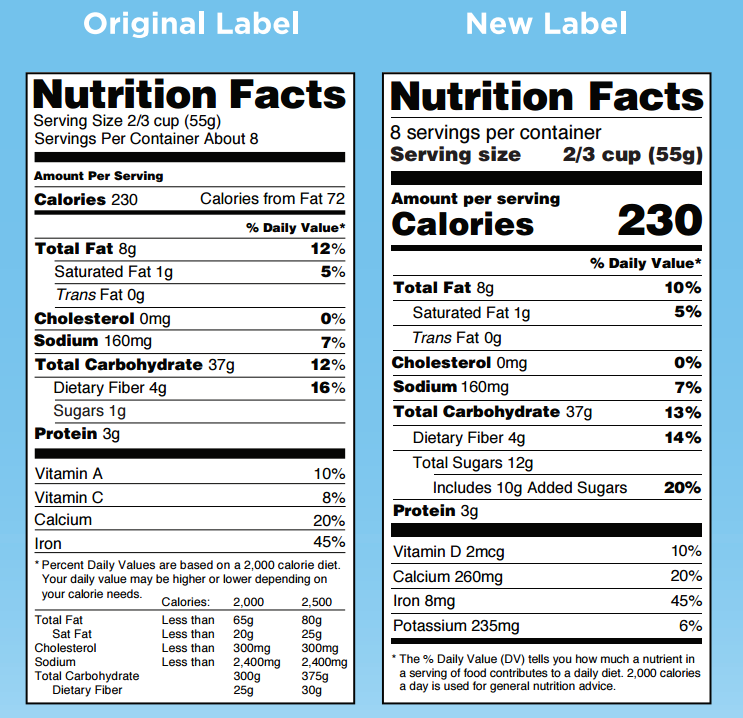
In the first major overhaul of the Nutrition Facts Panel in over two decades, the U.S. Food and Drug Administration announced today numerous changes that will be implemented within the next few years. One of the most important updates will be a line disclosing “added sugars,” along with a corresponding 10 percent-Daily Value—representing a limit of 50 grams (roughly 12 teaspoons) of added sugar towards the daily 2,000 calories recommended for most adults.
“Among several positive changes in the revised label, a new line disclosing the amount of added sugars with percent daily value in a food product or beverage is a major step forward in improving diet quality and public health,” says Dr. Frank Hu, Professor of Nutrition and Epidemiology at the Harvard T.H. Chan School of Public Health. “Highlighting added sugars will have important implications for food manufacturing and consumers’ behaviors. This change is consistent with the recommendation by the 2015 Dietary Guidelines’ Advisory Committee.”
The average American consumes 22 teaspoons of added sugar per day, most of which comes from processed and prepared foods. While total sugar per serving has been required on the Nutrition Facts Panel, it’s been up to the consumer to scan ingredients to determine how much sugar is added. Earlier this year, the 2015-2020 Dietary Guidelines included the recommendation of limiting added-sugar intake to less than 10 percent of daily calories. Now, the updated Nutrition Facts Panel update will put this guidance into practice. Once the rules are implemented, the label on a 20-ounce bottle of soda, for example, would let people know they are consuming around 130 percent of their added sugars limit for that day.

While highlighting added sugar is certainly a step in the right direction for helping consumers make more informed food decisions, the updates still leave room for improvement. When it comes to fat, the new panel will be consistent with the Dietary Guidelines’ removal of restricting percentage of “calories from fat,” which reflects evidence that type of fat is more important than total fat. Yet, “Total Fat” will still be featured, along with a percent Daily Value, which assumes a limit of about 35 percent of daily calories.
“The new FDA Nutrition Facts label is a step forward, especially because it provides information on added sugar, but I would give it a B+ grade,” says Dr. Walter Willett, Professor of Epidemiology and Nutrition and Chair of the Department of Nutrition at Harvard T.H. Chan School of Public Health. “The Daily Value for total fat should be removed as it has no scientific basis and is inconsistent with the Dietary Guidelines, which concluded that there was no evidence on which to set a limit. Also, the Daily Values for potassium and calcium are based on requirements that are out of date and flawed.”
Declaration of potassium will now be required and should be useful as many Americans have low intakes due to inadequate consumption of fruits and vegetables. However, the Daily Value—generally regarded as a goal for essential nutrients—is set at 4,700 mg a day and is unrealistic for most people. This number is based on a small study of men overloaded with salt who were treated with potassium supplements, and is seriously misleading. Declaration of Vitamin D will also be required, though featuring Vitamins A and C will now be voluntary.
Most food manufacturers will be required to use the new label by July 26, 2018, which will also feature following updates:
- A new design to highlight “calories” and “servings.”
- “Dual Column” labels to indicate both “per serving” and “per package” calorie and nutrition information for food products that could be consumed in one or multiple sittings, such as pints of ice cream or bags of chips. This update is designed to clearly inform individuals what they are consuming when they eat or drink the entire product at one time.
- The upper limit for sodium will be decreased slightly, from 2,400 mg to 2,300 mg per day, though this limit is likely still high for many people.
More from Dr. Frank Hu and Dr. Walter Willett in JAMA:
Malik VS, Willett WC, Hu FB. The Revised Nutrition Facts Label: A Step Forward and More Room for Improvement. JAMA. Published online June 06, 2016.

